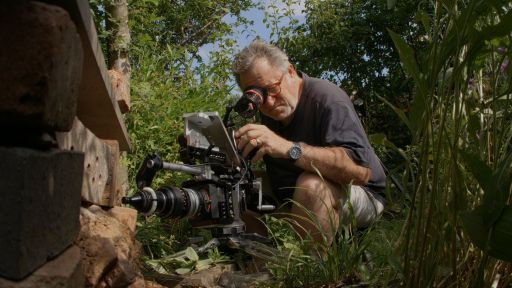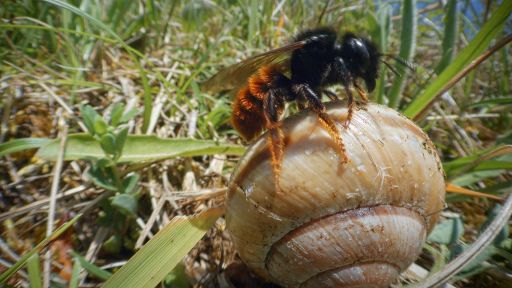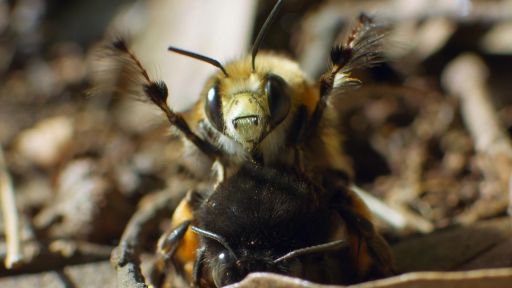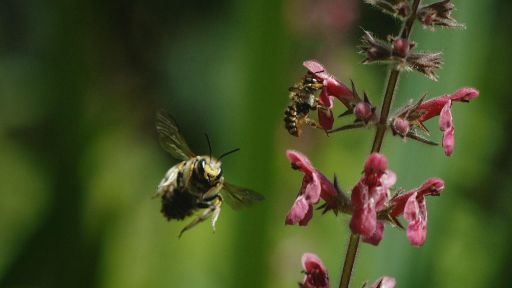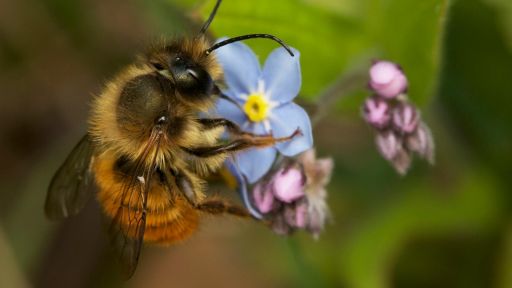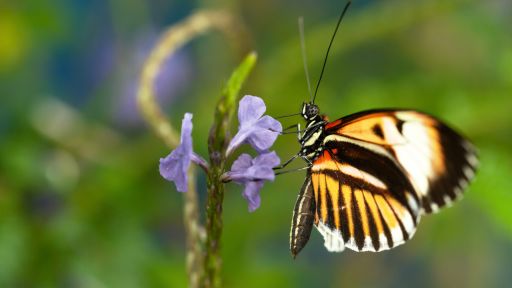TRANSCRIPT
- It seems like everyone is talking about bees.
It might be because there are 2.8 million honeybee hives in the U.S. alone.
With 20 to 60,000 bees per hive, that's more than 50 billion honeybees flying around our farms and neighborhoods every summer.
(bees buzzing) The honeybee is the closest thing there is to a domesticated insect.
We take care of them so that they can take care of us by helping many of our crops reproduce.
But honeybees aren't the only bees in town.
In fact, it's a little strange that they're are here at all.
Settlers from England brought the first honeybees to North America in 1622.
But those European honeybees arrived to a continent that was already teeming with wild bees, more than 4,000 species of them.
Yeah, there are 4,000 species of wild native bees living here in North America.
Some of those wild bees species are bumblebees.
They're probably our most famous wild bees, and they have a lot in common with honeybees.
They're often striped with yellow and black, and they live in colonies that can be active all summer long.
But most wild bees are pretty different.
Many of them are solitary, meaning that they live their lives alone.
In these species, each female is a hardworking single mom who builds her own nest, usually in a wood tunnel or underground burrow, lays her own eggs, and works alone to gather nectar and pollen to feed her babies.
Some of these solitary bees only live a few weeks as adults.
Wild bees come in just about every size, shape, and color you can imagine.
Some are big, some are tiny, some are fuzzy, some are shiny.
They can be yellow, orange, red, green, black, even blue.
More than 80% of all plant species rely on animals to move their pollen from flower to flower.
This process, called pollination, is how these plants reproduce.
All kinds of animals play a role in pollination: butterflies, moths, flies, beetles, wasps, ants, even birds and bats, but bees are the best pollinators out there.
And while honeybees get most of the attention, wild bees can be just as a effective, oftentimes even more so.
Bumblebees, for instance, can use their wing muscles to vibrate their bodies and release the pollen from certain kinds of flowers... (bee buzzing) a trick we call buzz pollination.
And unlike honeybees, which pollinate lots of different plants, many wild bees only visit a few flower species or even just one, like the death camas mining bee, the only bee that can eat the toxic pollen of the death camas flower.
Some of these relationships have developed over millions of years, and the survival of each partner depends on the other.
For plants, pollination can be just as important as water and sunlight.
It's pollination that ensures that plants can produce enough fruits and seeds to feed all the animals that eat them, with enough left over to make the next generation of plants.
And plants don't just feed animals and people; they provide habitat for other creatures, they help maintain healthy soil and water, and even produce the oxygen that we breathe.
So a healthy community of pollinators is part of a healthy planet.
Unfortunately, be population around the world are dwindling because of human impacts.
(somber instrumental music) In 2017, the rusty patched bumblebee became the first North American bee species to be listed as an endangered species in the U.S., and it's not alone.
By one estimate, about half of our wild bee species may be declining, and about half of those could be at risk of extinction.
Now here's the good news: we can all do something about it right where we live.
Wild bees need places to nest, and they don't ask for much.
For many species, a wood pile or a patch of loose soil could be just what they're looking for.
And don't worry.
While most wild bees can sting if you bother them, they're really pretty friendly.
Wild bees also need to stay healthy, so try to avoid using insecticides and other harmful chemicals, like weed killers, in places that wild bees frequent.
And of course, wild bees need food.
If you have a yard, a community garden, a rooftop, or even a window box, you can grow flowering plants native to your area.
Plant even one square foot of wild flowers, and I promise you, bees will find them and appreciate them.
And finally, share the good news.
Once you start attracting bees, tell everyone about your bee sanctuary.
Bees need all the friends they can get, and each one of us can make a difference.
(upbeat jazz music)

